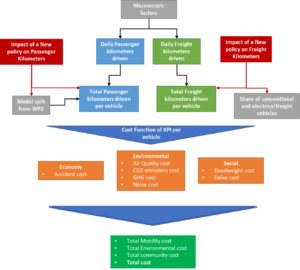Description
This section explains the SPROUT approach to assess the impact of policy responses, compared to the do-nothing scenarios that were derived under Section 2. Foreseeing through Scenario Building. It uses the SPROUT cost-based system dynamics tool.
The main output of the model is the calculation of costs (until 2030) generated to the system’s main sustainability areas by taking into account two cases: i) the city does not take any additional action (in 3 do-nothing scenarios) ii) the city implements the pilot measure and supports it with a set of policies. The final PIs that were taken as output were the following:
- Environment: Air quality costs, CO2 emission costs, Greenhouse emission costs and Noise costs
- Society: Accidents costs
- Economy: Traffic costs (Deadweight costs and delay costs) and fuel consumption
In order to derive the impacts of the different scenarios, local stakeholders were asked to assume the expected changes of the following aspects for each scenario (3 do-nothing scenarios, and 1 policy response scenario):
- total passenger kilometres
- total freight kilometres, and
- modal split
The impacts (=kilometers and modal split) are translated into monetary costs using
More information on the cost-based assessment can be found in D5.2 Urban Policy System Dynamics Model.
SPROUT materials and tools
Data required
Total passenger kilometres, total freight kilometres, and modal split: current state and changes under the different scenarios. The latter are estimations, based on local stakeholders’ expertise.
Further Information
This section builds on SPROUT Deliverable D5.2 Urban policy system dynamics model, authored by E. Xenou, D. T. Touloumidis, and G. Ayfantopoulou (CERTH).


